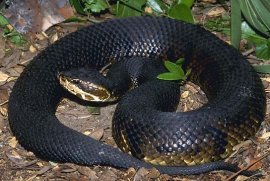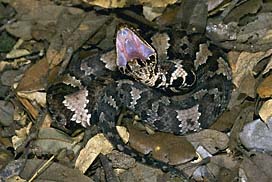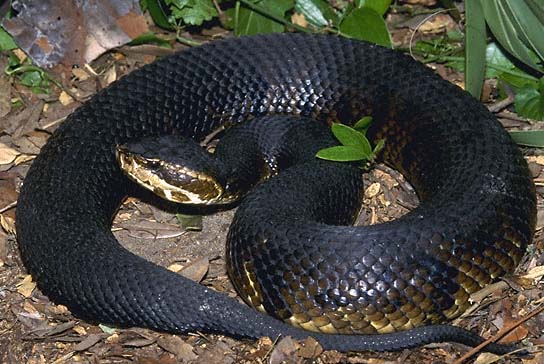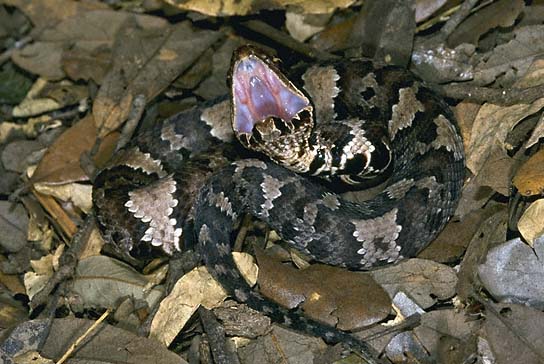Snakes
Description
20-74 1/2" (50.8-189.2 cm). A dark, heavy-bodied water snake; broad-based head is noticeably wider than neck. Olive, brown, or black above; patternless or with serrated-edged dark crossbands. Wide light-bordered, dark-brown cheek stripe distinct, obscure, or absent. Head flat-topped; eyes with vertical pupils (not visible from directly above as are eyes of harmless water snakes); facial pit between eye and nostril. Young strongly patterned and bear bright yellow tipped tails. Scale keeled, in 25 rows.
![]()
Warning
Do not disturb or attempt to handle! The Cottonmouth's bite is far more serious than that of the Copperhead and can be fatal. When annoyed, the Cottonmouth tends to stand its ground and may gape repeatedly at an intruder, exposing the light "cotton" lining of its mouth. Cottonmouths, Copperheads, and rattlesnakes belong to the pit viper family (Viperidae). These dangerous snakes have a heat-sensitive sensory organ on each side of the head that enables them to locate warm-blooded prey and strike accurately, even in the dark. The curved, hollow fangs are normally folded back along the jaw. When a pit viper strikes, the fangs rapidly swing forward and fill with venom as the mouth opens. The venom is a complex mixture of proteins that acts primarily on a victim's blood tissue. If you hear a rattlesnake shaking its rattle, back away. The snake is issuing a warning, and if the warning is ignored it may bite. Pit vipers are never safe to handle. Even dead ones can retain some neurological reflexes, and "road kills" have been known to bite. How to avoid and treat snakebites
Breeding
Live-bearing. Mates spring and fall. August to September females give birth to 1-15 young, 7-13" (18-33 cm) long. Females mature in 3 years and give birth every other year.
Habitat
Lowland swamps, lakes, rivers, bayheads, sloughs, irrigation ditches, canals, rice fields, to small clear rocky mountain streams; sea level to ca. 1,500' (450 m).
Range
Se. Virginia south to upper Florida Keys, west to s. Illinois, s. Missouri, sc. Oklahoma and c. Texas. Isolated population in nc. Missouri.
Discussion
Also called trap jaw or water moccasin. Unlike other water snakes, it swims with head well out of water. Although it may be observed basking during the day, it is more active at night. Preys on sirens, frogs, fishes, snakes, and birds.




